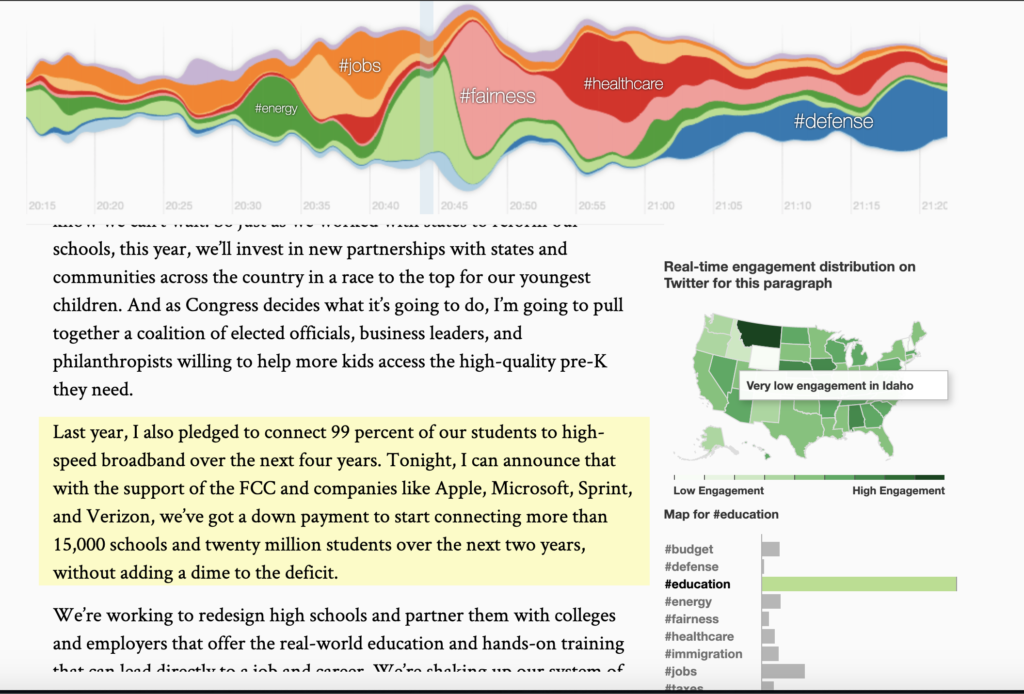As I was scrolling through the list of DH projects to explore for this blog post, one title specifically caught my eye. “#SOTU2014: See the State of The Union address minute by minute on Twitter” seemed like a mouthful but I’ve always been interested in politics so I decided to take a look at the project. The interactive page is an attempt to visualise the realtime impact that Obama’s State of the Union Address of 2014 had on Twitter, and the reaction it generated from the masses. The colourful graphics and the engaging visuals added to the appeal of the page but I was surprised at how little was available of the background of this DH project. The context behind why this was undertaken, what the data collection process was and how the data scientists behind this project followed up with its upkeep was absent and not much about this cropped up from repeated Google searches. But I think it is still worth talking about this project, just because there are multiple cases where the lack of documentation leads to a project being dismissed and not being given the recognition it deserves. This visualisation by a member of the Twitter visual insights team, Nicolas Belmonte and data scientist, Simon Rogers, enables viewers to navigate around the speech and see the instant reaction on Twitter to each part of it – themed by geography and subject.

The source for this project was simply the large database of tweets about Obama’s speech from its Twitter page which was easily accessible to the researchers given that one of them worked for the company. Not much is available about the process of retrieving and processing this data and the tweets but since the project has the term #SOTU2014 in its name, it looks like the researchers were looking for this specific hashtag in their searches when diving into the process of creating the visual and they then perhaps proceeded to collect all the tweets that contained that search term before grouping them into the above mentioned categories.
At the very top of the page, is a multicoloured steam-graph where the colour groupings represent certain topics that were addressed during the speech in 2014. For example, green denotes education and energy, blue represents defense, and red is healthcare. The same colour groupings appear on the map of the United States on the right hand side of the website with a scale representing intensity – the darker hues show high engagement, and the lighter hues show low engagement on Twitter in regards to the specific paragraph of the speech that is being highlighted on the left hand side of the website page. There’s also a third visualisation – the bar chart that also is a different way of depicting the same data. When a paragraph is highlighted, the specific topic on the bar chart that corresponds to the topic that is most dealt with in that paragraph is also highlighted. This page was both interesting and informative, fun to play around with and revealed a great deal about public opinion of Obama and his administration.
The project seems like it stands at the junction of history, political science, digital humanities and computer science, combining elements of all these fields in the way the data is processed and presented.
I find it hard to designate a specific target audience to this interactive model but I think this is an interesting question to think about. It could be useful to researchers in the political field but could also be a fun tool for just about anybody who is interested in either the American political system or in infographics and data visualisation.
I loved exploring this project and I’d be very interested in seeing more such work and seeing how infographics are used to relay information about politics and other such fields in the realm of digital humanities.
Maanya, this post was really interesting and the way that you explained the graph made it very easy to interpret! I agree that this website offers an interesting way to learn about the public opinion of Obama and his administration, I’d be interested to see more data infographics on speeches from other politicians as well.